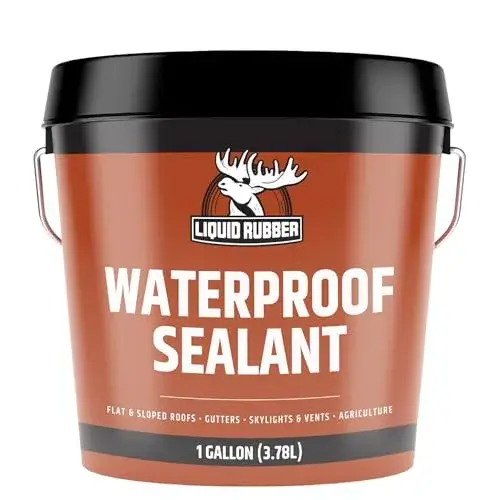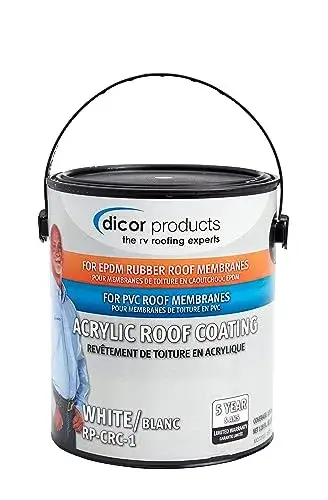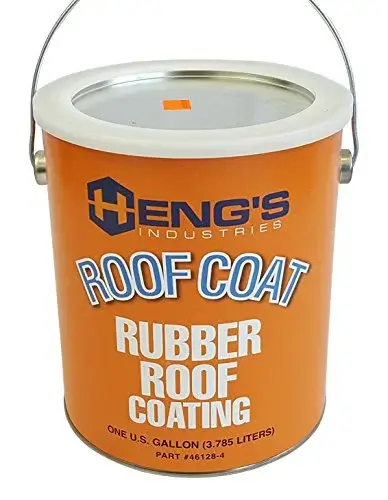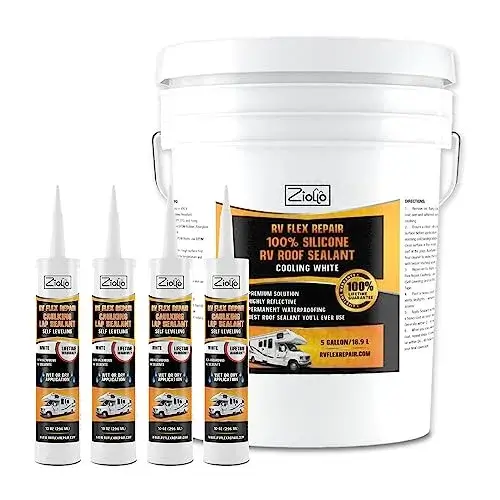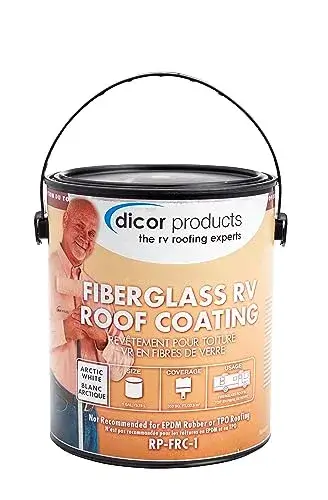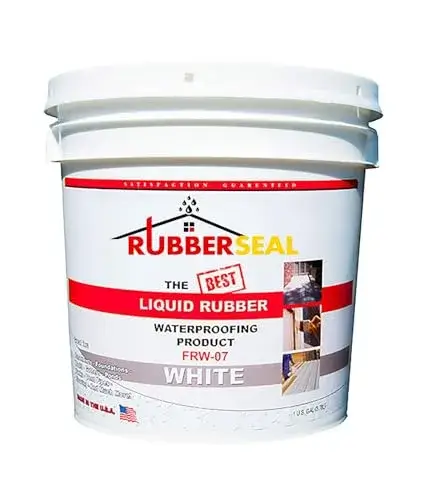Fellow road-warriors. Are you looking for the BEST RV roof coating to protect your valiant steed?
Of course, you are! Every road-warrior needs their protective armor.
RV roof coatings are essential for protecting your RV against the elements. If you’re traveling in even a casual capacity, the elements WILL wear down your defenses. Then, one night, before you know it, you’ll be waking up to an incessant leak dripping on your forehead!
Luckily, I’m no stranger to the science of RV roof maintenance. From coating materials to roof material types to the best application process, truly, I have suffered through the madness. And that’s why I’ve cut out the hard work and picked the best RV roof coating for you!
Liquid Rubber Roof Coating takes that title with enthusiasm. It offers high-quality durability, ample flexibility, and steadfast weather protection. Able to hold strong on even a single coat, this product really puts your RV’s longevity at the forefront.
But I picked other options too! Maybe you want a more economical solution? Perhaps something more tailored to your roof type? Or even a buy-it-for-life investment in your RV’s structural health?
Ask and you shall receive! Let there be no more wasted energy on dodgy roof maintenance. It’s time to protect your treasured steed with what it deserves.
Only the BEST.
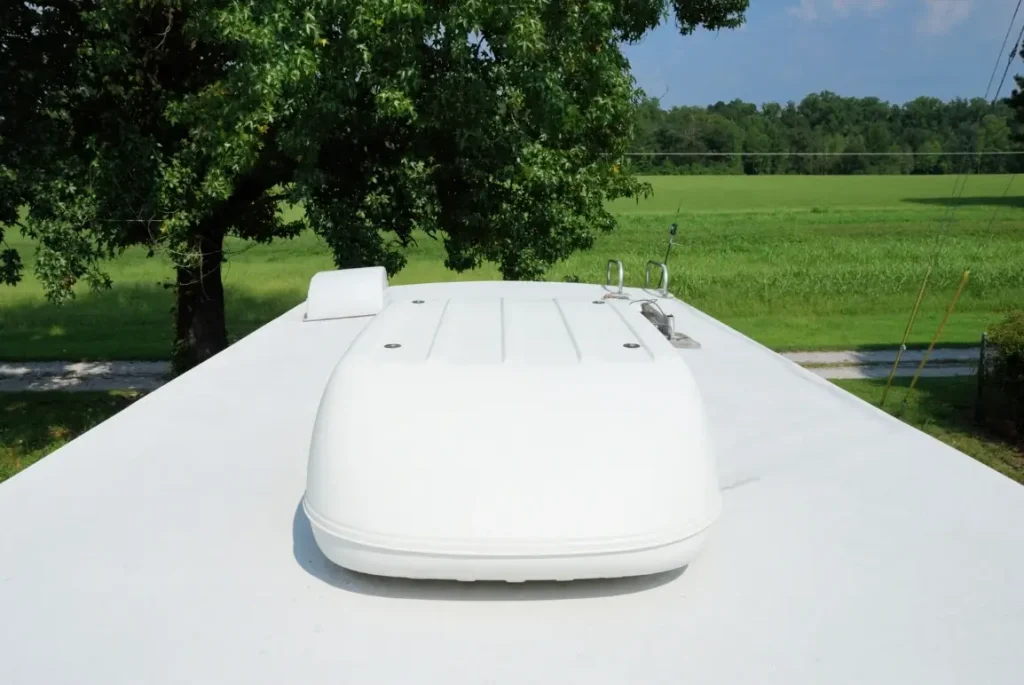
The Best RV Roof Coatings: Our Top 6 Picks
- Liquid Rubber Roof Coating [Best Overall]
- Dicor Rubber Roof Coating [Best Splurge]
- Heng’s Rubber Roof Coating [Best Budget]
- Ziollo RV Roof Coating [Best Bulk Buy]
- Dicor Fiberglass Roof Coating [Best RV-Tailored]
- Rubberseal Liquid Rubber Coating [Best Insulation]
What are the main types of Coatings for RV Roof Maintenance?
Firstly, RV roof types and materials. This is crucial info before you go buying any solutions.
Knowing the main types of RV roof coating makes all the difference when selecting a product. Each type of roof coating has its strengths and limitations. Consider your travel habits and climate wisely when choosing a product.
Here are the top three choices of RV roof coating types you should consider.
Urethane Roof Coating
Urethane roof coatings are the stalwart sentinels of the RV world. They offer superior durability and flexibility. This is crucial for RVs where withstanding the constant movement and vibrations of road travel is essential.
In my experience, urethane coatings are the best fit when heading into extreme weather conditions. They can handle high heat well but are still durable and flexible enough to withstand the freezing temperatures and frosts of winter. They’re a favorite all-season choice for RVers worldwide, and this versatility makes them excellent for boondocking and wild camping.
Look for a urethane coating that promises at least 2-3 years of protection. That way, you can feel comfortable knowing you’ve given your RV a sturdy, weatherproof shield for all the blizzards and blistering heat ahead.
Acrylic Roof Coating
Acrylic RV roof coatings are a go-to for many RVers. This is thanks to their affordability and ease of application. These water-based coatings are environmentally friendly and provide decent UV protection too. It’s not quite the all-around bulletproof shield of urethane. But the tradeoff is an easier application process
Generally, acrylic coatings are best for anyone who travels a lot in sunny climates. They reflect sunlight well, working to keep the interior of your RV cooler. For that reason, look for an acrylic RV roof coating with high reflectivity and elongation properties. This will further increase your protection in strong-sun conditions
Silicone Roof Coating
Silicone roof coatings are your best bet for waterproofing your RV. These coatings form a seamless, rubber-like layer that excels at sealing out water.
If you find yourself camping in rainy areas a lot, a silicone roof coating is a must-have. This goes double if you’re using it to seal leaks. While not as durable as urethane, silicone’s full water-sealing factor withstands winter moisture and ice exceptionally well—it’s easily the choice of roof coating for winterizing your RV.
Quick buyer’s tip! Choose a silicone coating with a high solids content (i.e., over 90%). This ensures it has better even coverage and durability.
Most Common RV Roof Materials and Types
Understanding your RV’s roof material type is also crucial for selecting the right coating! You want a coating that will stick to your RV’s roof very well in order to maximize its lifespan.
Here are the most common types of RV roofs. Check your rig and make sure you buy a coating intended for your RV’s type of roof!
- EPDM (Ethylene Propylene Diene Monomer). EPDM is well regarded for its durability and weather resistance. Ideal for various climates, it’s good for hot summers and chilly winters alike.
- TPO (Thermoplastic Olefin). TPO offers overall better puncture resistance and UV protection. It’s great for great for sun-soaked travels and tropical shenanigans.
- Fiberglass Roofs. Fiberglass roofs are common on RVs, and for good reason! Lightweight and sturdy, they’re resistant to UV damage and minor impacts. That said, fiberglass roofs generally require the most maintenance of all types, so be ready to apply a topcoat of paint and keep a quality RV waxing product on hand for that final oxidation-preventing finish.
- Aluminum Roofs. Durable and rust-resistant, aluminum roofs are built to protect RVers against corrosive climates. Beach lovers and coastal hoppers will get a lot of mileage out of an aluminum roof.
The 6 Best Roof Coatings and Sealants for RVs Reviewed
Righto! Now you know the type of roof material you’re rocking on your RV. Hopefully, you have some idea of the type of coating you need for it too.
All that’s left to do now is to find the BEST RV roof coating fit for your motorhome. Luckily, I have six for you!
Starting with the versatile, high-quality, take-no-names slathering of protective goodness…
Best Overall
1. Liquid Rubber Roof Coating
- Type of Coating: Polyurethane-based
- Coverage: 15 sq ft per gallon
Slather that protection on hard! If you want the BEST overall protection for your RV’s roof, look no further than Liquid Rubber.
This polyurethane-based coating stands out as a market leader for its flexibility and durability. It provides a watertight barrier that defends against:
- Moisture infiltration
- UV radiation
- Extreme weather conditions
- And the general wear and tear of the road!
Flexibility is the feature to boast here! This coating adjusts to the natural shifts and movements of your RV’s roof. As such, it doesn’t turn brittle, crack, or chip.
Additionally, this coating is also resistant to weather, chemicals, and impact. It even offers a bit of soundproofing against all those frenzied, cheap RV parks and campgrounds you’ll be parking up at. For cross-country trips of long drives and varied climates, there really is no better RV roof coating versatile enough for the job.
On the downside, it’s a bit of a pricey purchase. Especially so when you consider the gallon-to-coverage ratio. However, the high quality and versatility of the coating balance out those costs in the long run. One coat can get you very far!
For a supreme protective coating, there’s no better. Liquid Rubber roof coating offers a reliable, flexible, and durable weather shield. It’s a perfect fit for basically any RVer investing in their rig’s long-term health. Slap on a coat and hit the road suited up, no matter the climate.
Best Splurge
2. Dicor Rubber Roof Coating
- Type of Coating: Polyurethane-based
- Coverage: 125 sq ft per gallon
Ok, I lied. There’s one better!
Dicor’s Rubber Roof Coating is a premium-priced roof coating. It offers even more shades of protection than Liquid Rubber. But that comes at the cost of a higher price and a more difficult application process.
Functionally speaking, the two are very similar. They’re both polyurethane-based and both highly flexible liquid rubber roof solutions. That said, Dicor’s mix has a significantly higher coverage ratio.
Subsequently, the Dicor also has similar elastomeric properties. The elasticity and flexibility of the coating allow it to expand and contract with extreme temperature changes. (Kind of like natural rubber!)
This means the Dicor coating excels at resisting harsh weather and ultraviolet light. But even more notably, it’s fire-retardant. This comprehensive level of protection ensures that Dicor is a worthy investment, especially for full-time RVers living long-term in a rig exposed to year-round conditions.
Now, the major downside is that it can be tricky to apply this coating. It’s generally a tougher job than the Liquid Rubber overall. Even trickier, Dicor is more prone to blisters and bubbling if not applied correctly.
But IF applied correctly, the benefit is high coverage and even higher protection! It’s a steeper learning curve to master this solution, but dedicated nomads will gain a lot from taking the time.
Invest your time and money in the extensive coverage and durability of this must-have RVing maintenance essential. This coating will keep your RV well-protected for many years to come.
Best Budget
3. Heng’s Rubber Roof Coating
- Type of Coating: Fibered EPDM rubber
- Coverage: 200 sq ft per gallon
Damn! Look at that coverage-to-price ratio! For a budget-friendly roof coating that still delivers on performance, Heng’s is a great choice for any RV.
The type might be different, but the benefits are much the same. Heng’s is equipped for flexibility and the structural changes of temperature shifts. It also features a strong resistance to UV rays.
This flexibility ensures your roof remains intact through various weather conditions. More than that, it prevents cracking in the unrelenting sun. Heng’s is a standout choice of coating for sweltering summer days!
Now, this is a more budget-leaning product. That means that its high coverage ratio is dampened a touch by the product’s less protective tendencies. It’s a tricky solution to apply at the best of times. Moreover, to reach the level of durability of the Dicor or Liquid Rubber, you’ll need to apply multiple coats.
But that’s what makes it the economical option! Casual RVers subjecting their ride to moderate conditions will net top value from Heng’s. But if your RV is your most prized possession (or permanent home), you might consider investing in the higher-end options above instead.
Best Bulk Buy
4. Ziollo RV Roof Coating
- Type of Coating: 100% silicone
- Coverage: 60 sq ft per gallon
Well, well, well… speaking of economical! The Ziollo RV Roof Coating is the ideal choice for bargain-hunters and bulk-buying-bandits. Coming in a 5-gallon tub with four BONUS 10-ounce sealant tubes, there’s enough coating here to protect the Pyramids!
Bulk savings aren’t the only win here though. Ziollo also offers versatility and compatibility in spades. Whether your RV has an EPDM, TPO, aluminum, or fiberglass roof, Ziollo’s coating solution can handle it all.
Still not enough peace of mind for you? Well, Ziollo offers a lifetime warranty too! Ziollo is so confident in its coating that it promotes this as the last RV roof sealant you’ll ever need. How’s that for quality assurance?
The downside is that Ziollo Roof Coating is only available in a 5-gallon tub. For smaller projects, that’s likely way too expensive and way too much.
But this is a long-term and multi-use product. Its versatility-meets-quantity design makes it a go-to for a multitude of RV setups and projects, particularly luxurious Class As or top-of-the-line fifth-wheel trailers that deserve unparalleled protection. It functions as a surefire one-size-fits-all solution; with that much coating under a lifetime warranty, you aren’t going to need any other solutions anytime soon!
Get in, get zuped up with Ziollo, and get on the road. This is the no-hassle, long-term fix for all your RV roof coating needs for a very long time.
(Editor’s note: Ziollo have now gone ahead and scrapped the bonus four tubes (sadface). However, in return, they’ve now added a 1-gallon and 3.5-gallon option. It’s still the best bulk-buy price at the 5-gallon, only now with options for everyone else!
Best RV Tailored
5. Dicor Fiberglass Roof Coating
- Type of Coating: Acrylic fiberglass
- Coverage: 350 sq ft per gallon
Fiberglass roofs are less common than their rubber roof counterparts. But if your RV’s roof IS fiberglass, you need a product tailored for the job at hand.
That’s where Dicor Fiberglass Roof Coating comes in! This product has been conceived, developed, and continuously reoptimized to be THE solution for fiberglass RV roofs.
Much like polyurethane-based rivals, this coating offers flexibility. It dries with a pliable finish that expands and contracts with your roof’s movements. Additionally, it’s especially resistant to mildew and algae. This ensures your roof is both protected as well as clean, healthy, and free from the fungal friends that can compromise its integrity over time.
Unfortunately, this coating is a bit on the thinner side. It’s not excessively thin, but if you prefer your RV roof sealant thick and robust, it’s something to consider. You might need a few coats to get the effect you’re looking for. And once it’s applied, since it’s fiberglass, be prepared for a round of routine RV-exterior painting maintenance for the final topcoat.
It’s also not the most versatile product. But that’s because it’s tailor-made for RV fiberglass roofs! Other roof types will get much more mileage out of Dicor’s rubber variant. (Or any of the other more diverse products on this list.)
But for a coating custom-designed for fiberglass RV roofs, this is the only choice every time.
Best Insulation
6. Rubberseal Liquid Rubber Coating
- Type of Coating: Polyurethane-based
- Coverage: 60 sq ft per gallon
One final product review fit for the RVers who value top-notch climate control. If insulation is your priority, Rubberseal Liquid Rubber Coating is the way to go! This coating offers a robust level of protection with extra points stacked in the insulation factor.
Numerically speaking, Rubberseal is a star! It promotes an incredible elongation of over 1500%. This means it can bridge and seal large cracks while maintaining its flexibility. This is perfect for enforcing a solid barrier in all kinds of conditions.
But what really sends Rubberseal home is that insulation factor. This coating is built for cold and hot climates alike. It goes a long way in locking in a few extra degrees of leeway versus outside temperatures.
However, this is a multi-coat solution. Particularly if the goal is to maximize insulation. To get the best results, this is not a hassle-free product. However, getting the best results does mean a very well-insulated RV interior suited to living in winter climates!
So what’s the final score? Well, if protection or ease of application is the goal, Liquid Rubber or Ziollo Roof Coating might be better options. But for insulation?
Rubberseal Liquid Rubber Coating is the choice for you. Get the best climate control for your RV with this highly effective roof coating. As a bonus, you’ll also protect your rig against wear, tear, UV Rays, and the worst of it while you’re at it!
FAQs From RV Owners on Roof Maintenance
And that concludes the reviews! However, you might still have a few burning questions about RV roof coatings and sealants…
Have no fear! I have very satisfying answers.
What Is the Difference Between RV Roof Coatings and Sealants?
RV roof coatings and sealants ultimately serve different purposes. Roof coatings cover the entire surface of an RV’s roof. They provide a protective layer against UV rays, water, and other elements. That’s what makes them ideal for both protection and insulation!
Sealants, on the other hand, are used for spot-sealing seams, joints, and small areas prone to leaks. In that sense, think of coatings as a raincoat for all weather and sealants as an umbrella for quick showers.
How Do I Prepare My RV’s Roof for Coating?
Preparation is the key ingredient for successfully applying roof coating to an RV. Don’t slack off!
- Clean the roof thoroughly with a mild detergent and water.
- Remove any old RV roof sealants, flakes, or coatings.
- Repair any damage or leaks before applying the full coating.
- Allow the roof to dry completely.
- Apply the new coating! Proper preparation ensures the coating adheres well and lasts longer.
Can I Walk On an RV’s Roof After Applying a Coating?
No! At least not for the best results. Generally, you should avoid walking on the roof until the coating has fully cured. This can take anywhere from 24 to 72 hours. But that also depends on the product itself as well as the weather conditions.
Always check the manufacturer’s instructions for the most relevant information. However, I’d advise giving it a full three days to be safe to walk on. This will ensure the coating is well-set and won’t get damaged from your footsies.
How Do I Apply Roof Sealant to an RV?
Applying RV roof sealant is a very straightforward process.
- Clean the area thoroughly to remove all dirt and debris.
- Apply the sealant evenly over seams, joints, or any other cracks using a caulking gun.
- Smooth out the sealant with a putty knife (or your finger) for a neat finish.
- Allow it to cure per manufacturer instructions before further exposing the applied sealant.
How Long Does RV Roof Sealant Last?
The longevity of RV roof sealant varies based on the product and conditions. Typically though, the average solution lasts between 1 to 5 years. Regular RV roof inspections and maintenance on coatings can extend its lifespan. That said, I’d also recommend checking on your coatings after any harsh weather to ensure it’s still effective.
Our Verdict: What’s the Best Coating Product for RV Roofs?
All done! Who said RV roof maintenance had to be such a drag? I’ve got six of the best solutions that prove it doesn’t have to be right here!
What’s my personal pick? I’d recommend the Liquid Rubber Roof Coating every time. While it’s got a more lackluster coverage ratio than other options, the quality of that coverage is undeniable.
Alternatively, I’d suggest trying out the Ziollo RV Roof Coating. It’s a big and expensive bulk solution for sure. But thanks to its versatility and lifetime warranty, it’s also a long-term solution. It will cover you and cover you well for many years to come.
Otherwise, you could run around without roof coating? But then you’re just asking for trouble!
RV roof coating has a long list of benefits with just about the only con being that it’s a pain in the posterior to apply. But these infuriating maintenance jobs are what define us as RVers.
Any old soldier can take orders. But a true road-warrior cares for their steed… Maintains the gear… Practices the disciplines…
And the reward of such diligence? Many years of adventure in a well-looked-after home-away-from-home. A little bit of peace. And a lot of memories.
Maintenance sucks, but a leaky roof sucks more. Don’t wait until it’s too late. Buy some stellar RV roof coating, slather it on, and call it a day.
If nothing else, you’ll sleep better for it.

